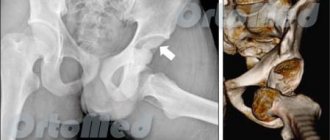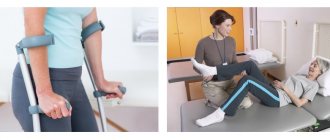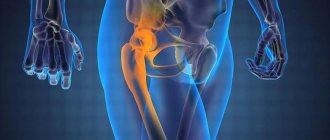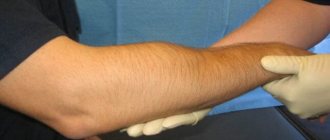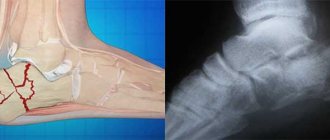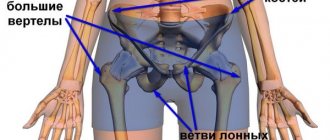Rehabilitation after a hip fracture includes measures aimed at healing the damage and restoring lost functions. As statistics show, almost a quarter of Russian residents are included in the risk group; every 5 minutes a hip fracture is recorded in our country. Not everyone receives qualified medical care, but the quality of the patient’s adaptation depends on recovery after surgery. For everything to go well, rehabilitation after injuries to the musculoskeletal system should take place in special medical centers. In such institutions, the patient will always be under the supervision of doctors who will be able to adjust the measures taken.
When should you start rehabilitation after a hip fracture? – the first steps should be taken already on the first day after immobilization of the limb. First, you need to perform breathing exercises, and later physical therapy is prescribed to prevent bedsores along with diet, physiotherapy and massage.
Early rehabilitation
Over the past 10 years, almost 6% of people in our country have suffered a hip fracture. The injury usually occurs in patients with osteoporosis or in the elderly, and injuries are also often reported in athletes or drivers who have been involved in accidents. Such destruction is dangerous due to its complications: tearing of muscles, blood vessels and nerves. Branches of a large artery pass through the thigh area, so life-threatening blood loss is often observed. To exclude relapses, rehabilitation after a displaced femoral fracture should be comprehensive and should be carried out from the first days after surgery.
In the first few weeks the patient is prescribed:
- load on the lungs - to ensure ventilation, the patient, lying in bed, takes deep breaths and exhalations 2-3 times a day;
- medications - prescribed only by a doctor to relieve pain, prevent muscle spasms, improve blood circulation in the affected limb;
- prevention of bedsores - changing the position in bed, raising the sacrum, moderate tension of the muscles of the whole body according to the doctor’s recommendations.
Independent exercises and especially movements of the affected limb are strictly prohibited. Three groups of powerful muscles are concentrated in the hip area, and even small loads can provoke re-injury with displacement. In the early period, the program is aimed at relieving pain and creating favorable conditions for wound healing.
Consequences of a hip fracture if treatment is incorrect
One of the most vulnerable places is the femoral neck; a fracture in the elderly can have the most fatal consequences if treatment is not started in time. It can be conservative in some cases, but the most effective is surgery. You should not rely on healing a broken bone on your own. The patient will be immobilized, which means:
- the occurrence of bedsores, which will be difficult to treat, since changing body position and treating wounds causes pain in the thigh;
- pneumonia due to impaired pulmonary blood flow;
- thrombosis of the lower extremities due to lack of stress on their muscles;
- progressive weakness.
All these factors lead to death. Therefore, if there are no strict contraindications to surgery, it must be done. This can be endoprosthetics, the most reliable method, or osteosynthesis, that is, fixation of bone fragments with special fasteners.
Late rehabilitation
It is carried out after the cast is removed, when the patient is already allowed moderate loads on the limb. During this period, a callus has already formed, but it has not completely strengthened, so measures are aimed at maintaining further regeneration and returning functions to muscles that have been without movement for several months.
Exercise therapy
Physical therapy is the basis for complete rehabilitation after a hip fracture. Gymnastics can be general, which is carried out to improve the health of the whole body, or special. The latest type of exercise therapy includes:
- flexion and extension in the knee and hip joints - in the first days after immobilization is carried out as carefully as possible;
- lifting the limb and bringing the knee to the body;
- learning to walk with a walker, crutches and a cane;
- classes on special simulators.
It is best to visit a medical rehabilitation center for recovery, where the program will be supervised by a doctor. The doctor will be able to select the optimal loads that will help restore lost functions and strengthen bone tissue.
Diet
Nutrition during the recovery period should be enhanced and contain large amounts of protein, calcium and magnesium. You also need to avoid fatty foods, because during immobilization almost no calories are consumed and problems with excess weight may appear.
The diet should include:
- boiled lean meat and fish;
- boiled eggs;
- low-fat milk, cheese, cottage cheese;
- jelly, jellied meat, jelly;
- legumes in limited quantities;
- greens, vegetables and fruits.
It is better to eat often, but in limited portions. Overeating is unacceptable; it is better to leave the table with a slight feeling of hunger. It is also undesirable to overeat before bed.
Physiotherapy and tekar therapy sessions
Physiotherapy procedures are prescribed from the 10th day and are carried out for several months for complete healing. Such rehabilitation after a fracture of the femur is recommended for all patients; at the initial stages, the doctor may prescribe medicinal electrophoresis, then supplement the sessions with shock wave therapy or warming up.
Tecar therapy shows good results:
- the therapeutic effect is achieved due to the penetration of radio waves into the tissue and heating of the tissue;
- energy is transmitted without radiation, thereby achieving maximum effect;
- after several sessions, blood flow improves in the affected area and tissue regeneration is stimulated.
Due to such sessions, it is possible to reduce the rehabilitation period after a hip fracture. Patients show noticeable improvement; this innovative method perfectly complements the rehabilitation program.
Hip fracture in old age: care and rehabilitation
Content:
Let's look at what types of hip fractures there are. How does the bone heal? How do doctors and their patients usually act when diagnosed with a hip fracture? What stages does a patient go through during rehabilitation after an injury?
Our old people. They grow old, weaken, and increasingly need our support. What was previously an unnoticed detail suddenly becomes a problem. When we are young, we don’t even notice that we have fallen. We got up and moved on. And for older people this becomes such a big problem that it can even lead to death.
With age, the vital forces of our body are depleted. Blood circulation in the tissues slows down, calcium is washed out of the bones (especially in women over age). The bones become fragile and can break not only from a fall, but from a simple awkward movement. He awkwardly got up from his chair, carelessly climbed down from the stepladder, stumbled - and his bones could not withstand even such a weak load. They break. And the restoration of bones in elderly people is very difficult, takes a long time, and often does not recover at all. A quarter of victims die from the consequences of a hip fracture in the first time after the injury.
The femur is one of the largest bones in our body, but it has a “weak link”, a very thin part of it – the femoral neck. When dropped, it is the one that most often breaks. And it is difficult to diagnose and conservative treatment.
Let's look at what types of hip fractures there are.
Of course, everyone hears about a hip fracture, since this is the most common injury. There are also fractures of the femoral body and trochanteric fractures, which are divided into intertrochanteric and pertrochanteric. Pertrochanteric fractures are accompanied by displacements in the hip joint. There are simple and comminuted fractures. Comminuted, as the name suggests, involves many fragments resulting from a fracture. Such fractures require urgent surgery to join the fragments together.
In childhood, fractures most often occur. This is a crack in the bone.
Complications can occur as a result of all these fractures. This is hemorrhage in the joint or severe bleeding, inflammation of bone tissue, destruction of tissues and organs around the damaged bone, blood poisoning. As you can see, the main complications are associated with bleeding due to a fracture. This is why urgent medical care is so necessary for an injured elderly person. Correct measures at the initial stage will help to avoid many terrible consequences.
What are the symptoms of a fracture of the femur or femoral neck?
- Firstly, it is, of course, pain. The pain can be either pronounced, acute and unbearable, or very weak.
- Secondly, subcutaneous hematoma. It forms in the affected area. In thin people, the hematoma is more noticeable. But in obese people it can be difficult to fix it due to the large amount of subcutaneous fat.
- Thirdly, unnatural leg position and impaired functions. The leg may be twisted relative to the pelvis without being able to return it to its normal position. The injured leg may be shorter. The victim may not be able to lift his heel off the floor. And so on.
There are many symptoms, but the answer is always the same - x-rays. It is he who gives a complete picture of the fracture. If the x-ray does not give such a picture, then the doctor prescribes additional diagnostics using MRI or CT.
How does bone heal?
In order for bones to heal, it is necessary:
- so that the blood and lymph that are around the damaged area clot. These fluids surround the damaged bones and trigger the necessary biochemical reactions;
- This clot contains cells from the periosteum, the inner layer of bone and bone marrow. They then have to restore the connection of the bones - to form a bone callus;
- then a dense membrane is formed from osteoblast cells of new vessels and connective tissue, which fixes the fragments.
A peculiarity of bone healing in elderly people is that they often have poor blood circulation in the damaged area, as well as few osteoblasts in the area of the fracture. The situation is also complicated if the bone fragments do not touch or infection occurs in this area.
How do doctors and their patients usually act when diagnosed with a hip fracture?
The first thing you need to do is urgently seek medical help, call an ambulance and come to the emergency room. The doctor will determine the existing symptoms, the presence of bleeding, bruises, hematomas and prescribe an x-ray. Without an image, it is impossible to make a final diagnosis, because symptoms never give the full picture. The pain may be severe or almost absent. A hematoma may or may not occur. It is more difficult to identify a hematoma in overweight people than in thin people. If the pain is weak, then the elderly person begins to think that something frivolous and trivial has happened. And wastes precious time.
At the emergency room, the doctor will definitely fix the sore leg in order to prevent it from moving; treat wounds, if any. And then the doctor and the patient decide what treatment will be: conservative medication or surgery.
Conservative treatment involves immobilization. This treatment gives a very poor prognosis. The patient remains bedridden, and this leads to numerous very unpleasant consequences. Due to constant compression of tissues, bedsores begin to form. For the same reason, congestion may appear in the lungs, and this already leads to frequent pneumonia. And for the same reason, blood clots can form. Needless to say, it is difficult for young people to cope with such problems, and it is three times more difficult for older people. It is not without reason that almost 25% of elderly patients with hip injuries die quite quickly.
Modern medicine is moving forward. And now patients with various hip fractures often undergo surgery. And the sooner it is done, the better for further rehabilitation. It is very important to have surgery within the first three days after a hip fracture. After all, a recent fracture heals faster, and blood circulation around the wound is not stopped. Everything promotes rapid tissue regeneration after surgery. This operation is called osteosynthesis and is performed under general anesthesia. The surgeon opens the damaged area, collects the fragments and puts them in place, and then connects them with screws. They firmly fix the bones, preventing them from moving. Such an operation significantly speeds up the rehabilitation process. The patient will be able to fully recover 3-4 months after the fracture, but he will be able to walk on crutches almost immediately.
Osteosynthesis is a modern and very effective way to help with hip fractures. However, in older people, tissue restoration is greatly slowed down, so osteosynthesis may not be effective.
Therefore, in older people, another method is most often used. This is hip replacement surgery.
The hip joint consists of two parts: the femoral head and the acetabulum. During endoprosthetics surgery, the doctor replaces one or both parts with an implant. Quite quickly after the operation, a person can sit up in bed and perform some simple movements. The patient will be able to walk with the help of crutches after his stitches are removed. And for six months you will have to adhere to certain rules.
Osteosynthesis and endoprosthetics are the most modern methods of treatment and rehabilitation of patients with hip injuries, especially in old age. They give a person a chance to live a full life. Modern endoprostheses are amazing. They are durable and comfortable, a person with such a prosthesis returns to normal life almost immediately after the operation, but with some restrictions, of course.
What stages does a patient go through during rehabilitation after an injury?
- drug treatment - prescribed by a doctor;
- pain relief - if the patient experiences severe pain, especially in the first period after injury, the doctor may prescribe analgesics to the patient;
- physical therapy—a set of exercises—should be prescribed by a doctor familiar with the characteristics of a fracture in a particular patient. Exercises are performed at low amplitude, avoiding sudden pain. As a rule, all exercises are aimed at gentle flexion and extension of the hip, smoothly moving it to the side. Such simple movements help restore mobility to the joint, improve blood circulation, and accelerate the tissue healing process;
- Therapeutic massage is necessary for almost everyone who has suffered a hip fracture. The doctor gently acts on the tissues in the area of damage, kneading them, improving blood circulation. This promotes accelerated recovery of the patient;
- physiotherapy - physiotherapeutic procedures that have a beneficial effect on the process of tissue healing after a fracture include the following: electrophoresis, magnetic therapy, hydrotherapy, laser therapy and UHF;
- diet - it is necessary to exclude unhealthy fats from the diet and add sources of calcium (cottage cheese and greens), protein (meat), and a large amount of fiber (fruits and vegetables).
Elderly patients will take longer to recover than younger people. This is due to age-related changes in their body, chronic diseases, and poor ability of tissues to regenerate. They always need the support of loved ones and proper care. Moreover, moral support and maintaining “fighting spirit” are no less important than massage and physical education. Sometimes older people are so afraid of their injury that they refuse to even try to get up or step on their sore leg. It should be remembered that this should not be allowed, because this is a direct path to complications and death. Up to 25% of older patients die from complications of a hip fracture in the first few months after the injury.
People who care for such patients need to ensure that the elderly person changes his body position as often as possible during the day. This will help avoid bedsores and congestion in the lungs, which can lead to pneumonia. The patient must not forget to do physical therapy prescribed by the doctor. It is necessary to monitor the diet of such a patient, this will help avoid constipation and ensure that the body receives the necessary vitamins. Without this, effective recovery is unlikely. In some cases, your doctor may prescribe coagulants to improve blood circulation in the area of injury.
Recovery in specialized centers
Immediately after the operation, many begin to look for where to undergo rehabilitation under the supervision of specialists in order to regain all lost functions after a hip fracture. For such tasks, special centers are suitable, where they offer a complete program:
- Exercise therapy according to timing with the use of simulators;
- massage under the supervision of a doctor;
- kinesitherapy;
- selection of physiotherapy methods;
- working with a psychologist.
Additionally, you can take a voucher for sanatorium treatment. Such measures are carried out at a later date and are recommended for almost all patients.
Stages of bone regeneration
In medical practice, the following regeneration stages have been identified:
- Catabolism of tissue structures and cellular infiltration. After damage, the tissue dies, cells disintegrate into elements, and hematomas appear.
- Stage of cell differentiation. This stage is characterized by primary bone fusion. With good blood supply, fusion occurs according to the type of primary osteogenesis. The process takes 10-15 days.
- Stage of primary osteon formation. Callus begins to form on the damaged area. Primary fusion takes place. The tissue breaks through with capillaries, its protein base hardens. A chaotic network of bone trabeculae grows, and they, connecting, form the primary osteon.
- Stage of callus spongiosis. This stage is characterized by the appearance of plastic bone cover, the cortical substance appears, and the damaged structure is restored. Depending on the severity of the damage, this stage can last several months or up to 3 years.
A prerequisite for a normally healing fracture is that the recovery stages proceed without disturbances or complications.
Factors influencing the rate of bone fusion
The healing of a broken bone depends on a number of factors that either speed it up or hinder it. The regeneration process itself is individual for each patient.
First aid is critical to the speed of healing. With an open fracture, it is important to prevent infection from entering the wound, because inflammation and suppuration will slow down the regeneration process.
Healing occurs faster when small bones are broken.
In open fractures, callus forms much longer if a wound infection develops, which is accompanied by bone sequestration and post-traumatic osteomyelitis. That is why, if the fracture is treated incorrectly, the formation of callus slows down or does not occur at all. In such situations, fractures that do not heal for a long time, characterized by slow consolidation, as well as false joints appear:
- If patients suffer from hypovitaminosis and vitamin deficiency (osteomalacia in pregnant women, rickets, scurvy).
- If there are disturbances in the activity of the parathyroid glands (decreased calcium concentration in the blood) and adrenal hyperfunction.
- The presence of concomitant diseases occurring in the chronic stage, as well as inflammatory processes. Any pathological processes in the body significantly delay the recovery period after a fracture.
- The presence of excess body weight negatively affects the healing process of bone tissue.
- Metabolic disorder.
- Failure to comply with the terms of wearing a plaster cast. Many cases of bone tissue taking too long to heal are due to the fact that a person does not want to walk in a cast for a long time and removes it before the time prescribed by the doctor. The fused area of the bone is under pressure and displacement occurs.
How quickly bones heal depends on factors such as the need to install an implant. This occurs in cases where there are too many bone fragments, they are very small, and it is not possible to reassemble them.
Healing rate of childhood fractures
In a child, fracture treatment occurs 30% faster than in adults. This is due to the high content of ossein and protein in the children's skeleton. The periosteum is thicker and has excellent blood supply. The skeleton of children is constantly increasing, and the presence of growth plates accelerates bone fusion even more. In children from six to twelve years of age, with damaged bone tissue, correction of fragments is observed without surgical intervention, and therefore, in most situations, specialists make do only with the application of plaster.
The most common fractures in children:
- Full. In such cases, the bone is separated into several parts.
- Compression fractures occur due to strong compression along the axis of the tubular bone. Healing occurs in 15-25 days.
- Green branch type fracture. The limb bends, causing cracks and fragments to form. Occurs when excessive pressure is applied with insufficient force to cause complete destruction.
- Plastic bending. Appears in the knee and elbow joints. Partial destruction of bone tissue without scars and cracks is observed.
Fracture healing rate in adults
The process of bone fusion is complex and takes a long time. With a closed fracture in one place of the limb, the healing rate is high and ranges from 9 to 14 days. Multiple injuries heal on average in about 1 month. An open fracture is considered the most dangerous and takes the longest to recover; the healing period in such cases exceeds 2 months. When the bones are displaced relative to each other, the duration of the regeneration process increases even more.
Healing of fractures of the upper extremities occurs slowly, but they pose less danger to humans than injuries to the lower extremities. They heal in the following periods:
- phalanges of fingers - 22 days;
- wrist bones - 29 days;
- radius - 29-36 days;
- ulna - 61-76 days;
- forearm bones - 70-85 days;
- humerus - 42-59 days.
Healing time for fractures of the lower extremities:
- calcaneus - 35-42 days;
- metatarsal bone - 21-42 days;
- ankle - 45-60 days;
- patella - 30 days;
- femur - 60-120 days;
- pelvic bones - 30 days.
The reasons for the low healing rate may be improper treatment, excessive stress on the broken limb, or insufficient calcium levels in the body.
Exercise therapy and physiotherapy after a hip fracture
Physiotherapy
Passive exercises can be performed almost immediately after surgery; in the absence of contraindications, you can also make circular movements with your feet, strain and relax the muscles of the ankle and thigh. The next stage is active exercises, which are selected by the doctor.
A special role is given to breathing exercises; it normalizes the drainage function of the lungs, avoids the development of inflammatory processes and congestion, saturates the body with oxygen and improves blood circulation.
Gymnastics must be done daily and only under the supervision of a specialist. The duration of the training is individual, but over time, for all patients, the duration and load increase, and the exercises become more difficult.
Physiotherapy
Laser and magnetic therapy, UHF, and electrophoresis have a positive effect. The procedures must be completed daily or every other day: the schedule, duration of each procedure and the course as a whole are determined by the doctor. It is recommended to take a course of physical therapy regularly, on average once a year, even after discharge from the hospital.
Features of rehabilitation in old age
Recovery for older patients takes longer than for younger patients, in some cases it lasts up to two years, and in some situations they never return to their normal lifestyle. The reason is age-related changes, in particular, low bone density and the presence of a large number of concomitant diseases. That is why elderly patients require special attention: the mattress and pillow on which they lie must be orthopedic, the patient’s body position must be changed up to 10 times a day to prevent bedsores, and in the absence of contraindications, the treatment program is supplemented by taking medications.
Blagopoluchiya employees strive to create the most comfortable living conditions and select a program that allows you to achieve the best possible results.
Objectives of rehabilitation after a hip fracture
- Prevent negative consequences: trophic disorders, bedsores, imbalance in the cardiovascular system, digestive problems, pneumonia and other lung complications.
- Restore motor and other functions of the body , help the patient adapt to new living conditions.
Contraindications during the rehabilitation period
The main rule is to follow all doctor’s recommendations. Do not break bed rest or self-medicate. All procedures must be carried out strictly according to indications; it is important not to overwork and observe the principle of regularity.
Rehabilitation is a whole complex of measures, and each of the methods used has a number of its own contraindications, which may include oncological and infectious diseases, chronic diseases in the acute stage, skin lesions at the site of the procedure, etc. The exact list is clarified by the doctor directly at the appointment when compiling individual program for a specific patient.
